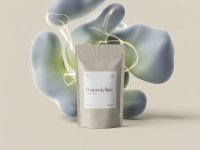
Turmeric
Description
Turmeric, a vibrant spice derived from the Curcuma longa plant, has been used for centuries in traditional medicine and culinary practices. Known for its distinct flavor and golden color, turmeric is gaining recognition for its potential health benefits, particularly its anti-inflammatory and antioxidant properties. This article provides a comprehensive yet accessible guide to turmeric, covering its dosage, side effects, interactions, and research-backed benefits.
Quick Overview: Turmeric At-a-Glance
- Key Benefit(s): Supports anti-inflammatory processes and provides antioxidant protection.
- Primary Mechanism: Contains curcumin, which inhibits inflammatory pathways and neutralizes free radicals.
- Best For: Individuals seeking natural support for joint health, mood elevation, and overall wellbeing.
- Typical Dose Range: 500-2000mg of turmeric or 100-500mg of curcuminoids daily.
- Key Caution/Consideration: Bioavailability of curcumin is low, so consider formulations with piperine (black pepper) or other absorption enhancers.
Table of Contents
Categories & Effectiveness
Learn about our rating methodologyBrain Health
Brain Antioxidant Shield
7/10Strong evidence of effectiveness
Cognition
Mental Acuity
7/10Strong evidence of effectiveness
Mood & Stress
Mood Elevation
7/10Strong evidence of effectiveness
Wellbeing Boost
6/10Moderate evidence of effectiveness
Anxiety Relief
4/10Moderate evidence of effectiveness
Systemic Health
Anti-Inflammatory (Systemic)
8/10Strong evidence of effectiveness
Systemic Antioxidant
8/10Strong evidence of effectiveness
Vascular Health
6/10Moderate evidence of effectiveness
Liver Protection
5/10Moderate evidence of effectiveness
Dosage & Side Effects
Recommended Dosage
- Pro Tip: To enhance absorption, choose turmeric supplements that contain piperine (black pepper extract).
- Best for: Those seeking general wellness benefits, start with lower doses and gradually increase as needed.
Potential Side Effects
- Watch For: Persistent digestive issues, allergic reactions (rare), or signs of liver problems.
Bioavailability & Half-Life
Interactions & Stacks
Pairing turmeric with healthy fats can improve curcumin absorption. Some also combine turmeric with ginger for enhanced anti-inflammatory effects.
Recommended Products
Kurkuma Kapseln Hochdosiert - 400 Kapseln (13 Monate) mit 700mg mit Curcumin & Piperin - vegan und mit Liebe aus Deutschland - Curcuma Kapseln
- Rated 4.7 stars by 67 customers
- Premium quality ingredients
Bio Curcuma mit schwarzem Pfeffer – 240 Kapseln – 4350mg Bio-Curcuma (Kurkuma) pro Tagesdosis – mit Curcumin & Piperin – hochdosiert, vegan – in Deutschland produziert & laborgeprüft
- Rated 4.6 stars by 5,136 customers
- Premium quality ingredients
Bio-Kurkuma 2280 mg (hochdosiert) mit schwarzem Pfeffer & Ingwer - 180 vegane Kurkuma-Kapseln mit dem Wirkstoff Curcumin I UK Hergestellt von Prowise Healthcare
- Rated 4.6 stars by 744 customers
- Premium quality ingredients
As an Amazon Associate we earn from qualifying purchases. Prices and availability are accurate as of the date/time indicated and are subject to change.
Benefits by Use Case
Joint Pain Relief
Curcumin's anti-inflammatory properties can help reduce joint pain and stiffness associated with osteoarthritis. Studies suggest it may work as well as ibuprofen for pain relief, but not as well as diclofenac.
User Review:
I have arthritis in my hands...I tried turmeric instead and the pain and swelling in my hands has been reduced dramatically.
Mood Enhancement
Curcumin may help alleviate symptoms of depression, particularly when used alongside antidepressants. Meta-analyses show significant clinical efficacy in ameliorating depressive symptoms.
User Review:
After 2 days of using it my body felt great, it works and it works great, no more prednisone for me
Mechanism of Action
Frequently Asked Questions
Where to Buy Turmeric
Based on quality, price, and customer reviews, here are our top recommended Turmeric supplements:
BeLive Curcuma Ingwer Gummies - Kurkuma Gummibärchen mit Ingwer- und Schwarzpfefferextrakt - Natürlich, Vegan, ohne Gelatine - 60 leckere Fruchtgummis
- Rated 4.4 stars by 18,128 customers
- Premium quality ingredients
Kurkuma Kapseln Hochdosiert Bio 1440 mg, 180 Ingwer Kurkuma Kapseln Mit Pfeffer/Curcumin Kapseln Hochdosiert Mit Piperin, Kurkuma Pulver Bio Curcuma Kapseln Hochdosiert, VitaBright Turmeric Curcumin
- Rated 4.5 stars by 11,825 customers
- Premium quality ingredients
Bio Curcuma mit schwarzem Pfeffer – 240 Kapseln – 4350mg Bio-Curcuma (Kurkuma) pro Tagesdosis – mit Curcumin & Piperin – hochdosiert, vegan – in Deutschland produziert & laborgeprüft
- Rated 4.6 stars by 5,136 customers
- Premium quality ingredients
As an Amazon Associate we earn from qualifying purchases. Prices and availability are accurate as of the date/time indicated and are subject to change.
Summary & Expert Opinion
Turmeric offers a natural approach to supporting overall wellbeing, particularly for those seeking anti-inflammatory and antioxidant benefits. Its potential to ease joint pain and elevate mood makes it a popular choice. However, it's crucial to understand the limitations of curcumin bioavailability and choose products designed to enhance absorption.
Key Strengths: Well-researched anti-inflammatory and antioxidant properties, potential for joint pain relief and mood elevation.
Key Weaknesses: Low bioavailability of curcumin, potential for mild side effects at high doses, possible interactions with certain medications.
Recommendation: Consider turmeric as part of a holistic approach to health, focusing on bioavailable formulations and consulting with a healthcare professional before use.
Detailed Technical Analysis:
The therapeutic potential of turmeric is largely attributed to curcuminoids, primarily curcumin, demethoxycurcumin, and bisdemethoxycurcumin. Curcumin's anti-inflammatory activity stems from its ability to modulate multiple signaling pathways, including inhibiting the activity of cyclooxygenase-2 (COX-2), lipoxygenase (LOX), and inducible nitric oxide synthase (iNOS). These enzymes play a crucial role in the production of inflammatory mediators.
Bioavailability remains a significant challenge. Curcumin undergoes rapid metabolism in the liver, primarily through glucuronidation and sulfation, which limits its systemic availability. Strategies to overcome this include:
- Piperine: This compound, found in black pepper, inhibits hepatic and intestinal glucuronidation, increasing curcumin's absorption.
- Liposomal formulations: Encapsulating curcumin in liposomes enhances its stability and cellular uptake.
- Nanoparticles: Nanoformulations improve curcumin's solubility and permeability, leading to higher plasma concentrations.
Research has explored curcumin's potential in various conditions, including osteoarthritis, depression, and neurodegenerative diseases. While preclinical studies show promising results, clinical trials often yield mixed outcomes, highlighting the need for more rigorous research with larger sample sizes and longer follow-up periods.
It's also important to consider potential drug interactions. Curcumin can affect the activity of cytochrome P450 enzymes (CYPs), particularly CYP3A4, which are involved in the metabolism of many medications. This could potentially alter the efficacy or toxicity of these drugs. Additionally, turmeric's antiplatelet effects may increase the risk of bleeding when combined with anticoagulant or antiplatelet medications.
In conclusion, turmeric and curcumin hold significant promise as natural health-promoting agents. However, further research is needed to fully elucidate their mechanisms of action, optimize bioavailability, and establish clear clinical guidelines for their use.









